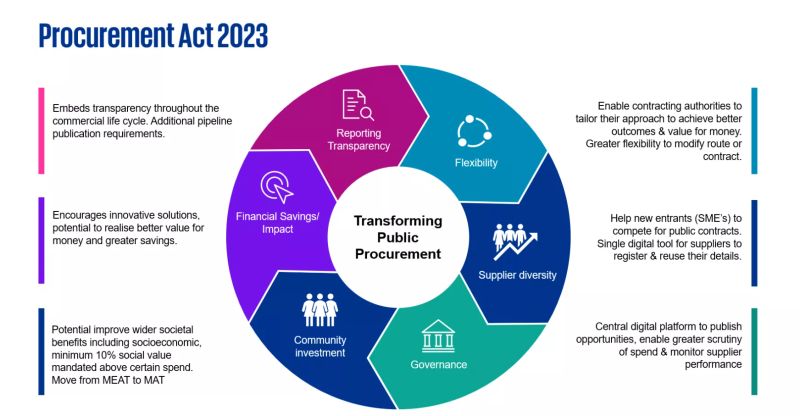03
Jul 2025
- BY Kevin Barry BSc(Hons) MRICS
- POSTED IN Latest News
- WITH 0 COMMENTS
- PERMALINK
- STANDARD POST TYPE

CFP Example: £1 Million Community Health Hubs
Project Overview
Contract Value: £1,000,000
Project: Design and construction of Community Health Hubs
Procurement Route: Competitive Flexible Procedure (CFP)
Stage 1: Pre-qualification Questionnaire
Traditional Approach (Old Regulations)
- Mandatory Selection Questionnaire (SQ)
- Fixed financial thresholds (e.g., £2m annual turnover)
- Pass/fail assessment only
- Limited flexibility to adjust criteria
NEW CFP APPROACH
- Optional “Conditions of Participation” – authority can choose whether to include this stage
- Proportionate requirements must be justified based on contract nature, complexity and cost
- Flexible financial criteria – can consider track record over capability for SMEs
- Innovation and sustainability can be weighted alongside financial standing
- Community benefit experience can be assessed (e.g., local employment, social value)
Key Changes:
- No mandatory selection stage – could go straight to competitive tendering
- SME-friendly criteria – focus on capability rather than just company size
- Social value integration from the start
Stage 2: Invitation to 4 Contractors for Outline Proposals
Traditional Approach
- Fixed shortlist numbers based on procedure type
- Standard evaluation criteria
- Limited interaction with bidders
NEW CFP APPROACH
- Flexible shortlist size – authority decides appropriate number
- Preliminary Market Engagement encouraged before formal process
- Pipeline Notices published if part of larger health infrastructure programme
- Enhanced transparency – reasons for shortlisting published
- Dynamic evaluation – can adjust approach based on market response
Key Changes:
- No rigid shortlist limits – could be 3, 6, or 8 contractors if justified
- Earlier market engagement through formal preliminary engagement notices
- Greater transparency in selection decisions
Stage 3: Competitive Dialogue on Technical Solutions
Traditional Approach
- Restricted dialogue scope
- Limited flexibility to change requirements
- Formal, rigid process
NEW CFP APPROACH
- “Deliberately broad” preliminary market engagement permitted
- Collaborative solution development encouraged
- Iterative refinement of health hub specifications
- Community consultation integration – residents’ needs can shape design
- Refining award criteria during process (under strict conditions)
- Innovation partnerships possible for complex health technology integration
- Net zero and sustainability solutions actively encouraged
Key Changes:
- Much broader dialogue scope – can discuss fundamental design approaches
- Community input integration – local health needs can shape solutions
- Award criteria refinement – can adapt evaluation as understanding develops
- Innovation focus – encourages creative health service delivery solutions
Stage 4: Final Tenders Incorporating Agreed Solutions
Traditional Approach
- MEAT (Most Economically Advantageous Tender)
- Limited post-tender clarification
- Fixed evaluation approach
NEW CFP APPROACH
- MAT (Most Advantageous Tender) – broader value assessment
- Enhanced assessment summaries provided to all bidders
- Detailed scoring explanations with specific references to bid content
- Value for money includes broader public benefit considerations
- KPI setting for health outcomes and community benefit
- Supply chain transparency requirements for local employment
Key Changes:
- Broader value definition – includes community health outcomes, not just economics
- Much more detailed feedback – specific scoring explanations provided
- Health outcome focus – KPIs for community health impact
- Supply chain visibility – local employment and SME subcontracting tracked
Award: Based on Most Advantageous Tender
Traditional Approach
- 10 calendar day standstill period
- Limited award information published
- Basic contract details only
NEW CFP APPROACH
- 8 working day standstill period (more predictable)
- Contract Award Notice published before contract signature
- Enhanced transparency – detailed contract information published
- Assessment summary sharing – unsuccessful bidders see winning bid scoring
- Public contract publication (full contract published within 90 days for £5m+ contracts)
- Performance monitoring through published Contract Performance Notices
Key Changes:
- More predictable timescales – working days vs calendar days
- Radical transparency – winning bid assessment shared with losers
- Public contract visibility – community can see full contract terms
- Ongoing performance publication – health outcomes and contractor performance published quarterly
Additional CFP Innovations for Health Hubs
1. Dynamic Markets Integration
- Health Hub Dynamic Market – could join existing frameworks for repeat health infrastructure
- Open frameworks – successive health hubs procured on similar terms
- Cross-authority collaboration – multiple councils could jointly procure
2. Enhanced Market Engagement
- Community co-design workshops during preliminary engagement
- Health provider input – GPs, pharmacists, mental health services involved in design
- User journey mapping – patient experience central to design development
3. Innovation and Sustainability Focus
- Net zero requirements – carbon neutral operation targets
- Modern Methods of Construction encouraged
- Digital health integration – telemedicine, digital consultations
- Modular design – adaptable spaces for changing health needs
4. Social Value Integration
- Local employment requirements throughout supply chain
- Apprenticeship creation – training opportunities for local residents
- Local SME participation – subcontracting requirements
- Community benefit delivery – measured and reported throughout contract
5. Performance Management Revolution
- Health outcome KPIs – patient satisfaction, appointment availability, community health metrics
- Real-time performance monitoring – published quarterly performance reports
- Contract modification flexibility – adapt services based on community health needs
- Supply chain transparency – local economic impact reporting
The CFP transforms this from a traditional construction procurement into a collaborative, community-focused, outcome-driven process that prioritizes health outcomes and community benefit alongside value for money.
